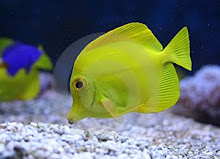
Parrot fish are named for their dentition; their numerous teeth are arranged in a tightly packed mosaic on the external surface of the jaw bones, forming a parrot-like beak with which they rasp algae from coral and other rocky substrates(which contributes to the process ofbioerosion). Many species are also brightly coloured in shades of blue, green, red and yellow.
Although they are considered to be herbivores, parrotfish eat a wide variety of reef organisms, and it is important to note that they are not vegetarian. Species such as Bolbometopon muricatum include coral (polyps) in their diet. Their feeding activity is important for the production and distribution of coral sands in the reef biome and can prevent algae from choking coral. The teeth grow continuously, replacing material worn away by feeding. Thepharyngeal teeth grind up coral rock that the fish ingests during feeding. After they digest they excrete the rock as sand helping to create small islands and the sandy beaches of the Bahamas and Caribbean. One parrotfish can produce 90 kg of sand each year.
Maximum sizes do not vary widely within the family, with the majority of species reaching 30–40 centimetres (12–16 in) in length. However, a very few species, such as the bumphead parrotfish reach up to 100 centimetres (39 in).
Their bodies are deep, with large, thick cycloid scales, large pectoral fins and homocercal tail fins.
Parrotfish use their pectorals as their primary means of locomotion, engaging the tail only to achieve higher speed.
Some females can turn into males.
Life Cycle
The development of parrotfish is complex and accompanied by a series of changes in color termed polychromatism. For most species, adult males and females have different color. The females are usually drab tones of green, brown or gray, while the males are a vivid, neon color. In the Mediterranean parrotfish (Sparisoma cretense), the females are brightly colored and the males are a drab grey.
In most parrotfish species, juveniles have a different color pattern than adults. Juveniles of some tropical species can alter their color temporarily to mimic other species. As juveniles mature they enter what is termed the initial phase coloration during which they may change color and gender. For most species, initial phase fish are males and have the beginnings of adult male coloration. However, initial phase fishes may include generally mature females. The many color varieties seen in parrotfish are part of the different phases of development that parrotfish go through.
Feeding parrotfish of most tropical species form large schools grouped by size. Fights of several females presided over by a single male are the norm in most species, the males vigorously defending their position from any challenge. If the dominant male of a school is removed, one of the females will change gender and adopt the dominant male role.
Parrotfish are pelagic spawners; that is, they release many tiny buoyant eggs into the water which become part of the plankton. The eggs float freely, settling into the coral until hatching.
parrot fish fight








.jpg)
.jpg)
.jpg)


.jpg)

.jpg)










